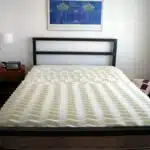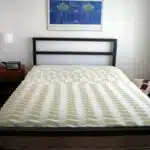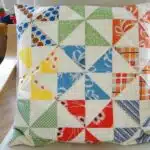As a professional housekeeper, one of the most important tasks I have is making beds. A well-made bed not only looks neat and tidy but also ensures a comfortable and inviting atmosphere for guests or occupants. However, making a bed may seem like a simple task that requires no special skills, but it entails following certain steps to achieve perfection.
In this article, I will guide you on how to properly make a bed according to proven techniques used by professional housekeepers. Whether you are preparing your bedroom for yourself or hosting guests, this guide will equip you with the necessary skills to create an inviting and cozy sleeping environment. With these techniques, you can elevate your bed-making skills to a level that exceeds expectations and makes your guests feel welcomed and valued.
Choosing The Right Bedding
When it comes to making a bed, choosing the right bedding materials is crucial. The primary factor to consider is the type of fabric used in the sheets and blankets. Cotton is the most commonly used material for bedding as it is soft, breathable and easy to care for. However, other options such as linen or silk may be preferred for their unique textures and luxurious feel.
Another important consideration when selecting bedding is matching colors. It is best to choose a color scheme that complements the room decor and creates a cohesive look. Neutral tones such as white, beige or gray are versatile choices that can be easily paired with different accent colors. Alternatively, bold shades or patterned designs can add personality and visual interest to the bedroom.
To ensure a comfortable night’s sleep, it is also important to select bedding appropriate for the season. Lightweight fabrics such as cotton or linen are ideal for warmer weather, while thicker materials like flannel or fleece provide warmth during colder months. By selecting bedding materials that match your preferences and needs, you can create a cozy and inviting atmosphere in your bedroom.
As you prepare to make your bed, the first step is removing old bedding.
Removing Old Bedding
After choosing the right bedding, it’s time to start making your bed. However, before you can start putting on fresh sheets and blankets, you need to remove the old bedding first. This step is important because it ensures that your bed is clean and fresh for a good night’s sleep.
One thing to keep in mind when removing old bedding is to check for any stains or spots that may have accumulated over time. If there are any, treat them accordingly before washing the bedding. This will help prevent the stains from setting in and becoming more difficult to remove. There are many stain-removing products available in the market that can effectively get rid of even the toughest stains.
Once you’ve removed the old bedding and treated any stains, you may wonder what to do with it next. Instead of throwing it away, consider donating it to a local shelter or charity. Many people are in need of clean bedding, especially during colder months. Donating old bedding not only helps those in need but also reduces waste and promotes sustainability. With the old bedding taken care of, you can move on to fluffing your pillows for a comfortable night’s sleep.
Fluffing Pillows
After properly aligning the pillows, it’s time to fluff them up. Fluffing pillows not only adds a touch of elegance to your bed but also provides the much-needed support for your head and neck while sleeping. To achieve the perfect pillow arrangement, first, remove all pillows from the bed and start with the largest ones.
Using both hands, grab opposite corners of the pillow and give it a good shake. This technique helps redistribute the filling inside and ensures that it retains its shape throughout the night. For down or feather pillows, toss them in the dryer on low heat for 10-15 minutes with a couple of clean tennis balls. This process will help re-fluff the feathers inside and keep them from clumping.
For decorative pillows, use a gentle touch when fluffing to avoid damaging any embellishments. Once you’ve fluffed all pillows, arrange them from largest to smallest, with two sleeping pillows at the back and smaller decorative ones in front. Pillow arrangement is essential as it creates an inviting atmosphere in your bedroom while keeping you comfortable throughout the night.
Transition: Now that we have our perfectly arranged pillows, it’s time to move on to another crucial aspect of making a bed – fitting the fitted sheet.
Fitting The Fitted Sheet
As housekeepers, we know that fluffing pillows is just the first step in making a bed that is both comfortable and visually appealing. The next step involves fitting the fitted sheet onto the mattress. Think of it like dressing a baby – you want to ensure that the fit is snug but not too tight.
Sheet size is an important consideration when making a bed. It’s essential to select sheets that are proportionate to your mattress size – too small and they won’t fit properly, too big and they will bunch up underneath you as you sleep. Once you have the right size sheet, make sure to properly place it on the bed. You want to start at one end and work your way around, smoothing out any wrinkles or folds as you go.
Dealing with corners can be tricky when making a bed, especially if you have limited mobility or strength in your hands. Start by lifting each corner of the fitted sheet and tucking it tightly under the mattress. Then, slowly work your way around the bed, ensuring that each corner is tucked in snugly. Don’t worry if there are still some wrinkles – those can be smoothed out later with a little extra effort.
Transition: Now that we’ve discussed proper placement of the fitted sheet, let’s move on to tucking in those pesky corners for a flawless finish.
Tucking In The Corners
- Smoothing wrinkles: Ensure wrinkles are removed from the top sheet, fitted sheet, and mattress pad before tucking.
- Tucking around mattress: Pull the sheet tight and tuck it in all the way around the mattress.
- Keeping sheets tight: Hold the sheet tight and tuck the excess fabric under the mattress, making sure the sheet is snug against the mattress.
- Smoothing wrinkles: Run hands along the sheet and mattress pad to ensure the wrinkles have been removed.
- Tucking around mattress: Take the excess fabric on the sides and tuck it deeply into the crevice between the mattress and the box spring.
- Keeping sheets tight: Grab the bottom corner of the sheet on all four corners of the bed and pull it tight, tucking it securely underneath the mattress.
Smoothing Wrinkles
To create a perfectly made bed, one must pay attention to the details of tucking in the corners. Smoothing out wrinkles is crucial in achieving a polished and elegant appearance for any bedroom. Preventing creases on your bedding is not only aesthetically pleasing but also ensures that your linens last longer.
Choosing the right fabric for your bedding can make all the difference in preventing wrinkles. Opt for fabrics with higher thread counts as they tend to be softer and more durable. When washing your sheets, avoid using hot water and high heat when drying them as this can damage the threads and cause creasing. Instead, use warm water and tumble dry on low heat or line dry to preserve the quality of your linens.
Once you have chosen the right fabric and washed it properly, it is important to smooth out any remaining wrinkles before tucking in the corners. Use a hand-held steamer or iron on low heat to remove any folds or creases from your bedding. This extra step will give your bed a crisp finish that will leave you feeling like you are sleeping in a luxurious hotel room every night.
In conclusion, tucking in the corners of your bed is just one step in creating a perfect sleeping environment. By paying attention to the details like preventing creases and choosing the right fabric, you can achieve a flawless look that will impress anyone who enters your bedroom. Remember to always take care of your bedding so that it lasts longer and looks its best every time you make up your bed.
Tucking Around Mattress
When it comes to making the perfect bed, tucking in the corners is just one aspect to consider. Another crucial step is ensuring that the bedding is tucked tightly around the mattress. This not only creates a neat and tidy appearance but also prevents the sheets from slipping and becoming wrinkled during sleep. As a professional housekeeper, it is essential to pay attention to these details to provide your guests with a comfortable and visually pleasing sleeping space.
When tucking in your bedding around the mattress, start by pulling the sheet taut over one corner of the bed. Then, adjust the tightness as you move along each side of the bed, making sure that there are no wrinkles or excess material. This will prevent any exposed areas that may cause discomfort or irritation while sleeping. By taking this extra step, you can ensure that your guests have a restful night’s sleep without having to worry about their sheets coming loose.
In addition to adjusting tightness, it is also important to cover any areas of the mattress that may be exposed. This includes tucking in any excess material or duvet covers between the mattress and box spring or bed frame. Not only does this create a clean and polished appearance, but it also protects your bedding from dirt and dust accumulation. By incorporating these techniques into your bed-making routine, you can provide your guests with an inviting and comfortable sleeping environment that they will appreciate.
Keeping Sheets Tight
As a professional housekeeper, tucking in the corners of the bed is just one aspect to consider when making the perfect bed. Another crucial step to ensure a comfortable and visually pleasing sleeping space for your guests is keeping the sheets tight. Using sheet clips can help keep the sheets in place, preventing them from slipping and becoming wrinkled during sleep.
Adjusting mattress height is also important when it comes to keeping sheets tight. A mattress that is too high or too low can cause wrinkles and bunching of the sheets, leading to discomfort for your guests. Make sure to adjust the mattress height accordingly before tucking in the sheets tightly around the mattress.
By incorporating these techniques into your bed-making routine, you can provide your guests with an inviting and comfortable sleeping environment that they will appreciate. Keeping sheets tight prevents discomfort during sleep and creates a polished appearance that shows attention to detail. As a professional housekeeper, taking these extra steps ensures that your guests have a restful night’s sleep without having to worry about their bedding coming loose or wrinkling.
Straightening The Sheet
To achieve a well-made bed, it’s important to straighten the sheet properly. There are two methods of sheet straightening: smoothing and tucking. While both methods have their merits, one is generally preferred over the other.
Smoothing involves simply pulling the sheet tight over the mattress and smoothing out any wrinkles or creases with your hands. This method is quick and easy, but may not provide as neat an appearance as tucking. Tucking involves pulling the sheet tight and folding the excess fabric under the mattress, creating a crisp, tailored look. However, this method can be more time-consuming and requires some practice to perfect.
To maintain a neat appearance, it’s recommended that you straighten your sheets every morning when making your bed. This will keep them looking fresh and wrinkle-free throughout the day. Additionally, if you notice any wrinkles or creases throughout the day or before going to bed at night, take a moment to smooth them out.
When straightening your sheets, keep in mind that personal preference plays a large role in which method you choose. Some people prefer the casual look of smoothed sheets while others enjoy the crispness of tucked sheets. Whichever method you choose, remember that consistency is key in maintaining a neat appearance for your bed. With these tips in mind, let’s move on to adding the flat sheet for a fully made bed.
Adding The Flat Sheet
- When selecting a flat sheet, it is important to consider the size of the bed, the material of the sheet, and the general aesthetic of the space.
- To properly place the sheet on the bed, start by laying the sheet on the bed face down, centering it lengthwise and widthwise with the mattress.
- Secure the sheet on each corner of the bed with the mattress and repeat with the remaining corners.
- For additional security, tuck the sheet between the mattress and the box spring.
- To complete the look, smooth out the sheet and tuck the corners of sheet under the mattress.
- Finally, add any decorative accents and pillows for a finished look.
Select The Right Sheet
Selecting the Right Sheet: A Vital Step in Properly Making Your Bed
When it comes to making your bed, the type of sheet you choose can make all the difference in achieving a comfortable and visually appealing final product. The first thing to consider is the material of your sheets. Cotton is a popular choice thanks to its breathability and durability, but also keep an eye out for sheets made from linen or bamboo, which are known for their softness and hypoallergenic properties. The thread count is another important factor to take into account – generally speaking, the higher the thread count, the softer and more luxurious your sheets will feel against your skin.
Once you’ve chosen the perfect set of sheets for your bed, it’s important to store them properly so that they remain in good condition for as long as possible. Store them in a cool, dry place away from direct sunlight and make sure they are completely dry before folding and putting them away. To help keep them fresh between washings, consider using a sachet filled with dried lavender or another fragrant herb that will add a pleasant scent while also repelling moths and other insects.
In conclusion, selecting the right sheet is an essential step towards achieving a comfortable and beautiful bed. Take care to choose materials that suit your preferences and needs while keeping an eye on thread count, and be sure to store your sheets properly so that they remain fresh and inviting. With these tips in mind, you’ll be able to create a cozy retreat that you’ll look forward to sinking into each night.
Place The Sheet On The Bed
Now that you have selected the perfect sheet for your bed, it’s time to add the flat sheet. When it comes to placing the sheet on the bed, there are a few things to keep in mind. First, determine which way the sheet should go – smooth or fitted side up? This is largely a matter of personal preference, but many people prefer the smooth side up for a more luxurious feel against their skin.
Next, it’s important to properly layer your sheets. The flat sheet goes on top of any blankets or duvets that you may be using. Make sure it is centered on the bed and that there is enough overhang on both sides. If you like a more polished look, you can fold down the top edge of the sheet to create a neat cuff.
Once your flat sheet is in place, tuck it in at the foot of the bed and along both sides. This will help keep it securely in place throughout the night and prevent any annoying bunching or shifting. With these tips in mind, adding your flat sheet will be an easy and satisfying step towards creating a beautiful and comfortable bed for yourself or your guests.
Secure The Sheet
After successfully layering the flat sheet on top of any blankets or duvets, it is essential to secure the sheet properly. To achieve a neat and tidy-looking bed, smooth corners and taut edges are necessary. Start by tucking in the sheet at the foot of the bed, making sure that it is tight enough to prevent any bunching or shifting as you sleep.
Next, move on to the sides of the bed, tucking in more fabric until it feels secure. It is crucial to ensure that there is enough overhang on both sides while keeping all edges smooth. You may also want to consider using sheet suspenders or clips if you have trouble keeping your sheets in place throughout the night.
A well-secured flat sheet will make all the difference when it comes to getting a good night’s sleep. Not only will it prevent any discomfort caused by bunched-up sheets, but it will also keep your bedding looking neat and inviting for guests who may visit your home. Remember these simple steps next time you add a flat sheet to your bed, and enjoy a peaceful night’s rest!
Folding The Top Sheet
After successfully adding the flat sheet, it’s time to move on to the next step: folding the top sheet. This step may seem simple, but it can make a big difference in the overall appearance of your bed. A properly folded top sheet can give your bed a clean and organized look.
Proper folding involves neatly tucking in the sides and foot of the sheet, creating crisp corners. For those who prefer a more decorative look, layering techniques can be used to create intricate folds. It’s important to take your time when folding the top sheet as neatness is key.
To help achieve a polished look, consider using a table like this one:
| Fold Type | Appearance | Difficulty |
|---|---|---|
| Basic Fold | Simple and tidy | Easy |
| Hospital Corners | Sharp and neat | Moderate |
| Decorative Folds | Intricate and elegant | Difficult |
By selecting a fold type that aligns with your desired appearance and skill level, you’ll be able to create a beautifully made bed every time. Remember, proper folding and neat corners are essential for achieving an organized appearance while decorative folds add an extra touch of elegance.
Next up is placing the duvet or comforter onto the bed. By following each step carefully, you’ll soon have a perfectly made bed that will serve as both functional and aesthetically pleasing.
Placing The Duvet Or Comforter
When making a bed, it is important to first choose the right type of duvet or comforter to use. Depending on the climate and season, a breathable option such as cotton may be best for the summer, while a more insulating option such as down may be best for the winter. Once the correct duvet or comforter has been chosen, it is important to arrange it properly on the bed. The duvet or comforter should be laid flat and centered on the bed, and the edges of the duvet or comforter should be tucked in securely around the mattress.
Choosing The Right Duvet Or Comforter
When it comes to making a bed, choosing the right duvet or comforter is crucial. The fill of your bedding can make all the difference in ensuring a good night’s sleep. There are many options available, including down, feather, wool, and synthetic fills. Consider your personal preferences and budget when deciding which type of fill to choose.
If you opt for a natural fill like down or feather, be sure to care for your duvet or comforter properly. Fluff it daily and air it out regularly to maintain its loft and prevent mold or mildew growth. If you have allergies or prefer a more eco-friendly option, synthetic fills may be the better choice for you. These materials are usually hypoallergenic and easier to care for than their natural counterparts.
In conclusion, selecting the right duvet or comforter can greatly impact the quality of your sleep. Take into account your preferences and needs when choosing a fill type, and be sure to care for your bedding properly to ensure its longevity. A comfortable bed is essential in creating a welcoming and relaxing space for yourself or guests in your home.
Arranging The Duvet Or Comforter
After selecting the right duvet or comforter, it is important to properly place and arrange it on your bed. Choosing the correct size for your bedding is crucial in achieving a neat and polished look. The duvet or comforter should cover the entire mattress, with a slight overhang on each side. A well-fitted duvet or comforter not only looks better but also stays in place throughout the night.
Once you have placed your duvet or comforter correctly, fluffing it daily will help maintain its loft and ensure a comfortable sleep experience. Fluffing techniques include shaking out any clumps of fill, smoothing out wrinkles, and arranging the bedding evenly across the bed. Properly fluffing your duvet or comforter not only enhances its appearance but also helps regulate temperature control while sleeping.
In addition to proper placement and fluffing techniques, styling your duvet or comforter can further enhance the overall look of your bed. Color coordination and pattern mixing are key factors to consider when styling your bedding. Choose colors that complement one another and mix patterns that have similar color schemes for a cohesive look. Taking these steps in arranging and styling your duvet or comforter can create an inviting space that promotes relaxation and restful sleep.
Fluffing The Duvet Or Comforter
After ensuring that the fitted sheet and flat sheet are tucked neatly, it is time to fluff your duvet or comforter. Fluffing technique is an essential part of bed-making as it gives your bedding a plush look and feel. However, there is a difference between fluffing a duvet and a comforter.
For duvets, start by shaking out any clumps or wrinkles on the top layer. Then, holding onto two corners of the cover with one hand, use your other hand to grasp the center of the duvet and give it a sharp snap downwards. Repeat this snapping motion towards each corner until you have evenly distributed the filling within its cover. On the other hand, comforters are bulkier in nature and require more attention when fluffing them. Start by grabbing onto opposite corners of the comforter and shake it vigorously to prevent any lumps from forming.
Fluffed bedding may provide an inviting ambiance for guests; therefore, it is critical to get it right every time. To achieve optimal results in fluffing your duvet or comforter, follow these three simple steps: 1) Shake out any clumps or wrinkles on top of your bedding before starting; 2) Hold onto opposite corners and shake vigorously for comforters while using sharp snaps for duvets; 3) Repeat until you have evenly distributed the filling throughout its cover.
As we move towards finishing up our bed-making process, we can now proceed to layer decorative pillows for an added touch of elegance.
Layering Decorative Pillows
While some may argue that decorative pillows are unnecessary and only add clutter to a bed, they can actually elevate the overall look of a well-made bed. When done correctly, layering decorative pillows can create a visually appealing and inviting space for guests or simply for personal enjoyment.
One key aspect to consider when layering decorative pillows is mixing patterns. It’s important to choose patterns that complement each other rather than clash. A good rule of thumb is to choose one dominant pattern and then pair it with smaller-scale prints or solids in coordinating colors. This will create depth without overwhelming the space.
Another factor to keep in mind is color coordination. The decorative pillows should tie in with the overall color scheme of the bedding and room decor. Using accent colors from the bedding or curtains is a great way to tie everything together. To help visualize this concept, refer to the table below for examples of pattern mixing and color coordination:
| Dominant Pattern | Coordinating Print/ Solid | Accent Colors |
|---|---|---|
| Stripes | Polka dots | Blue, white |
| Floral | Plaid | Pink, green |
| Geometric | Chevron | Gray, yellow |
By following these guidelines and incorporating your own personal style, layering decorative pillows can truly enhance the overall aesthetic of your bed. Next up: adding accent throws for an extra touch of coziness and comfort.
Adding Accent Throws
Accent throws are an important part of bedding décor, as they provide an eye-catching and stylish element to the room. Depending on one’s personal style and taste, there are a variety of different types of accent throws that can be used. It is important to choose the right color for the accent throw, as this can make or break the overall look of the bed. Furthermore, one must consider the other hues and shades used in the room in order to ensure that the accent throw works with the rest of the décor.
Types Of Accent Throws
When it comes to adding accent throws to a bed, there are various types of throws that can be used to enhance the overall aesthetic. One type is mixing patterns, which involves using throws with different patterns and designs to create a unique and visually appealing look. For instance, a throw with floral patterns can be paired with a striped or geometric patterned throw for a chic and stylish look. It is important to ensure that the patterns complement each other rather than clash.
Another important factor to consider when selecting accent throws for a bed is color coordination. Throws that match or complement the color scheme of the bedding and room decor can help tie everything together for a cohesive and polished look. If the bedding has neutral tones, bold colored accent throws like red or blue can add a pop of color and visual interest.
Lastly, it’s essential to keep in mind that there are no strict rules when it comes to choosing accent throws for a bed. Experimenting with different types of throws and styles can help find what works best for your space. Whether you prefer simple monochromatic accents or bold prints, incorporating accent throws into your bedding design allows you to showcase your personal style while elevating the overall look and feel of your bedroom.
Choosing The Right Color
When it comes to adding accent throws to a bed, choosing the right color is crucial in achieving a cohesive and polished look. Matching the decor with the accent throws can help tie everything together and create a harmonious atmosphere in your bedroom. It’s important to consider personal preferences while selecting colors as well. If you prefer bold and vibrant hues, then incorporating bright-colored accent throws can be an excellent choice. Alternatively, if you prefer muted tones, then opting for neutral-colored throws might be more suitable.
To choose the right color for your accent throw, start by considering the dominant color in your bedding and room decor. You can opt for an accent throw that matches or complements this color to create a cohesive look. For instance, if your bedding has shades of blue, then adding an accent throw in a complementary shade like green or yellow can add visual interest without clashing with the existing decor.
Lastly, when selecting the right color for your accent throw, it’s essential to keep in mind that there are no strict rules. Experimenting with different color combinations can help find what works best for your space and personal style. Whether you prefer monochromatic accents or bold prints, incorporating accent throws into your bedding design allows you to showcase your unique taste while elevating the overall look and feel of your bedroom.
Finishing Touches
After making the bed, it is time to add the finishing touches that will make it look inviting and comfortable. One important element is choosing pillows that complement the bedding and provide support for a good night’s sleep. Consider using a mix of decorative pillows and standard sleeping pillows to create a layered effect. Arrange them in a way that looks aesthetically pleasing, such as placing two larger pillows in the back and two smaller ones in front.
Another way to enhance the bed’s appearance is by incorporating bedside storage options. This not only adds functionality but also helps keep clutter at bay. Consider adding a nightstand or bedside table with drawers or shelves for storing books, glasses, and other essentials. You can also use decorative baskets or trays for holding items like remotes or extra blankets.
When adding these finishing touches, remember to maintain a cohesive look throughout the room. Choose colors and patterns that work well together and fit with the overall style of the space. By paying attention to these details, you can create an inviting atmosphere that promotes relaxation and restful sleep.
Next, we will discuss how to maintain a clean bed to ensure it stays fresh and comfortable for longer periods of time.
Maintaining A Clean Bed
Moving on to maintaining a clean bed, it is essential to note that preventing bed bugs is crucial. These pesky insects can easily find their way into your bedding if you are not careful. To prevent this from happening, ensure that you vacuum your mattress and box spring regularly. Additionally, wash your bedding in hot water frequently as this can kill any bed bugs that may have found their way into your bedding.
To maintain optimal cleanliness, it is recommended that you change your bedding at least once a week. This ensures that any dirt, sweat, or dead skin cells are removed from your bedding promptly. Additionally, you should wash your pillows every three months or so to keep them fresh and hygienic.
In conclusion, by following the steps outlined above, you can ensure that your bed remains clean and free of unwanted pests such as bedbugs. However, despite taking all the necessary precautions, sometimes issues may arise. In the next section, we will explore some common problems people encounter when making their beds and how to troubleshoot them effectively.
Troubleshooting Common Issues
Common mistakes can happen even when making a bed, no matter how simple the task may seem. One common mistake is not tucking in the sheets properly, resulting in wrinkles and an unkempt appearance. Another mistake is using the wrong size of bedding, which can make it difficult to properly cover the entire mattress. A third mistake is not fluffing and adjusting the pillows, leaving them flat and uncomfortable.
Alternative solutions are available for these common issues. To avoid wrinkles and a messy-looking bed, it’s important to take the time to tuck in all sides of the sheets and blankets tightly. Using a larger size of bedding than your mattress will also help ensure that everything fits properly. Lastly, fluffing pillows regularly can keep them looking fresh and comfortable.
By taking these alternative steps, you can ensure that your bed looks neat and comfortable at all times. Making a bed may seem like a small task, but it’s important to do it right in order to provide guests with a welcoming environment and ensure that you get a good night’s sleep yourself. Remembering these tips can help you avoid common mistakes and create a relaxing oasis in your bedroom without any added stress or frustration.
Conclusion
The proper way to make a bed is not just about making it look nice, but also ensuring that it’s comfortable and clean. Begin by choosing the right bedding that suits your preferences and needs. Then, remove any old bedding and fluff your pillows for maximum comfort.
When fitting the fitted sheet, ensure it’s tight enough to prevent wrinkles but not too tight that it tears or shifts during the night. Tuck in the corners neatly for a crisp finish. Adding accent throws can elevate the overall look of your bed.
Lastly, maintaining a clean bed is important for hygiene purposes. However, if you encounter any issues such as wrinkled sheets or lumpy pillows, do not fret as these are common problems that can be easily solved.
As a professional housekeeper, I highly recommend following these steps to properly make your bed. Not only will it provide you with a good night’s sleep, but it will also impress any guests who may visit your home. So go ahead and give your bed the attention it deserves – after all, you spend one-third of your life in it!
Image Credits
- “Bed Jump” by jamesjyu (featured)



![How To Keep Sheets On A Bed: 10 Strategies 3 Bed sheets [Explored 2013-04-27]](https://green-life.blog/wp-content/uploads/2023/04/pH7FwL8jspjq-150x150.jpg.webp)

























